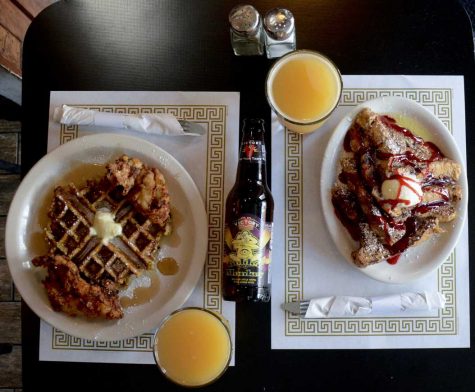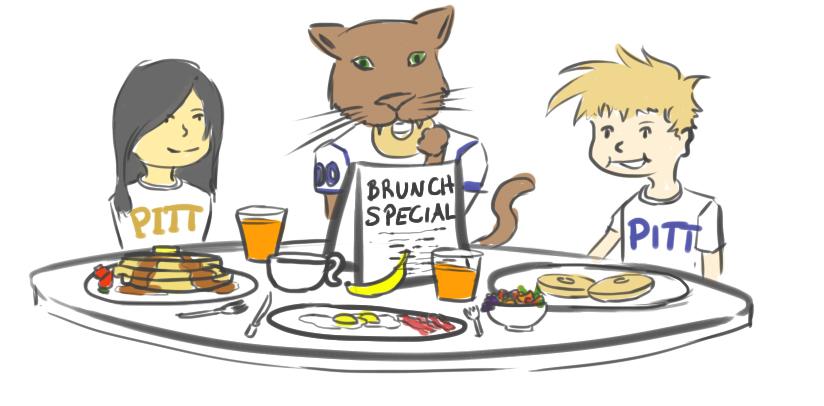As a child, Chris Gilbert spent many a Sunday morning sitting in a church pew. But right after, he remembers, he’d chow down on fluffy pancakes.
“Around noon, we met at Grandma’s house for brunch. That’s what we did,” said Gilbert, who’s worked as a chef at The Yard, a Shadyside gastropub, since its opening in 2014.
The Gilberts would gather around a table piled high with all of the standards — eggs, pancakes, bacon — and dig in. It’s an experience he sees as classic Americana.
“It’s comfort food. It’s nice to have,” Gilbert said.
With its late weekend start, varied options and social atmosphere, brunch has spread around Pittsburgh in the last five years. But beyond the bites, buddies and occasional booze, brunch has a long history — and may end up being a healthy addition to the American diet.
Peter’s Pub, the late-night Oakland institution, is the latest to join the growing trend with the addition of a brunch menu, Saturdays only, on Aug. 27. Including “classic choices” like french toast, as well as breakfast burritos and beer-based mimosas, the menu was partially inspired by Peter’s general manager Dave Brehl’s own childhood experiences.
“I think of growing up and going to hotel brunches [when I think of traditional brunches],” Brehl said. “But going to a bar hasn’t really been seen.”
Brunch’s exact roots are difficult to pin — the word first appeared in Harper’s Weekly in 1895, according to Smithsonian Magazine — but it has a few constants. It is held on weekends, usually Sunday but sometimes Saturday. The food options can vary but involve a smattering of breakfast and lunch food: yogurt, fresh fruit, eggs benedict and lox. And it was often served in hotels because of the widespread closing of family-run restaurants on Sundays.
Restaurant owners then tried to cash in on the wave of waffles and mimosas by adding their own brunch menus. From trendy gastropubs to local taverns, everyone started adding brunch to already-crowded tables. This rapid spread — from sparse to stock — is what surprises Arthi Subramaniam, the Pittsburgh Post-Gazette’s food editor.
“Who’d have thought that a bar that’s open at 2 a.m. would be up to open up for brunch?” Subramaniam asked.
She also separated the rise of the meal itself from Pittsburgh’s growing fame as a “Mecca for food.”
Over the past few years, the city’s reputation for culinary competence has seen a marked upswing. Primanti’s used to be the pride of Pittsburgh. Now, Zagat, a restaurant-rating organization, approved Täkō, Cure and Chaz and Odette, adding to Pittsburgh’s notable food culture. The cumulative growth of quality dining made Pittsburgh Zagat’s No.1 city for food in the country in its most recent rating, over New York, Chicago and the rest of the metropolises that usually dominate cultural rankings.
As a reviewer, Subramaniam looks for foods done right — with quality and sometimes surprising ingredients and execution, though the recipes themselves could be old favorites.
The addition of alcohol to brunch comes from the idea of the “hair of a dog” — trying to cover up the hangover from the night before with further boozing, an idea that has no basis in scientific fact. Either way, refreshing libations like the mimosa or bloody mary were added to menus.
Subramaniam noted how popular the bloody mary bar — with plenty of salty and pickled options — is in Pittsburgh brunches as well at places like The Yard and Meat and Potatoes, located Downtown.
Overall though, while Subramaniam admits that a cocktail “jazzes [brunch] up,” it isn’t a requirement to make a standout spread. Overall, the options should be “leisurely food.”
Peter’s head chef, Leonard Jaeger, designed the brunch menu with a focus on keeping things simple but intriguing. Take Peter’s chicken and waffles, done with a savory cornbread waffle instead of the typical fluffy Belgian cake.

“There’s a lot of ways to do the same thing,” Jaeger said. “Anyone can put something on a plate — to do it right is another thing.”
The addition of brunch at Peter’s, according to Brehl, was partially inspired by their own staff. Long Saturday night shifts at the popular bar were often followed by Sunday brunch outings by the staff.
“[Brunch] brings our crew together,” Brehl said.
It’s the relaxing food — and welcoming environment — that attracts college students in droves. Gilbert mentioned that The Yard tends to turn over tables three to four times from 10 a.m. to 4 p.m. every Saturday and Sunday.
“Brunch are the two busiest days of the week,” Gilbert said. “We get large groups that enjoy each other’s company.”
Those groups include plenty of students, a clientele Gilbert says The Yard looks forward to every fall. Kamila Setaro, a senior political science major, is one of those customers. She tries to brunch two to three times a month on Sundays with her friends or boyfriend. She sees food as a natural binder between individuals.
The communal feel draws other college students, like Pitt senior communications major Ariel Pastore-Sebring. Despite being a self-described foodie, she doesn’t let her love of food color her love for brunch.
“[Brunch is] not a meal,” Pastore-Sebring said. “It’s become more of an activity, something to do … [that] social aspect is really healthy.”
Pastore-Sebring shares memories similar to Gilbert’s with a family brunch on Saturday or Sunday part of the b-roll of her childhood. She looks at brunch as an opportunity to “cleanse yourself” of the previous night.
All of this eating and drinking is stretched out over the course of the meal, as Pastore-Sebring and Gilbert noted from their own experiences. The average American spends a total of 67.8 minutes a day eating, according to a 2011 tally by the U.S. Department of Agriculture. Going off Gilbert’s estimates, the average brunch table at The Yard stays there for at least 90 minutes.
Spreading out the time between courses is good for the body, according to Jeffrey Lucchino, Director of Sports Nutrition at UPMC. He compares the body to a sponge: Eating fast activates a “snooze button,” contributing to lethargic behavior and bloating. Eating slow lets your head keep better track of your hunger.
“Your brain needs 20 minutes to realize that something is being consumed,” Lucchino said. That delay means eating slow makes you become “fuller quicker” and eat less.
Brunch also invites a group to share food among themselves. With food sharing, you “can have almost everything on the menu” with a big group, as Subramaniam observed. Pastore-Sebring saw brunch as a meal in a more European tradition, like an Italian antipasti or Spanish tapas. That let’s everyone have a nibble without breaking the bank — or their stomach.
As for the booze, even if it may make things cloudy, the effect on a hangover-addled brain and body can still feel beneficial — to an extent.
“[Brunch] is catch up time for the pallette and the brain,” Subramaniam said. “[But] if you order five bloody marys, I wouldn’t call that healthy.”
While all that booze might be helpful to Peter’s bottom line, sharing a few plates would be just fine as well. Brehl is hoping within a few months, they might have to open the upstairs of the pub for spillover crowds.
“That’s going to be our barometer,” Brehl said.


